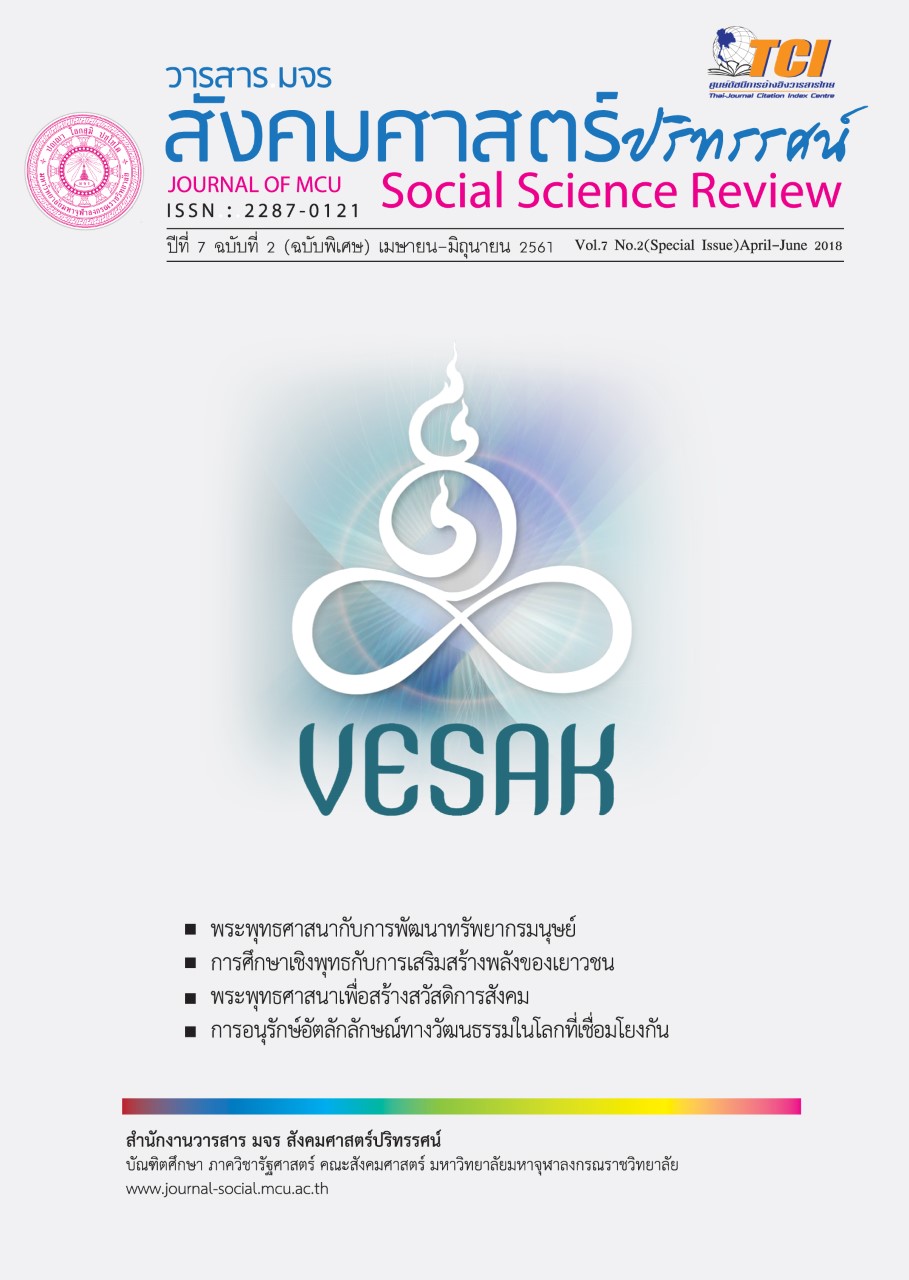บทบาทของกษัตริย์ในการอุปถัมภ์ พุทธศาสนาในประเทศไทย
คำสำคัญ:
กษัตริย์, การอุปถัมภ์, พระพุทธศาสนาบทคัดย่อ
วิทยานิพนธ์ฉบับนี้มีวัตถุประสงค์ 1) เพื่อศึกษาพัฒนาการของพระพุทธศาสนาในประเทศไทย 2) เพื่อศึกษาพัฒนาการของพระพุทธศาสนาในรัชสมัยของรัชกาลที่ 3 และพระจอมเกล้า 3) เพื่อบูรณาการการพัฒนาของพระพุทธศาสนาในรัชกาลที่ 4 แนวทางใหม่ในการสร้างองค์ความรู้ใหม่เกี่ยวกับ 'รูปแบบการพัฒนาของพุทธศาสนาในประเทศไทยในรัชสมัยของพระเจ้ามงกุฏ' การวิจัยครั้งนี้เป็นการวิจัยเชิงคุณภาพผ่านการวิเคราะห์ข้อมูลจาก Pali Canon, ข้อคิด, ข้อความและเอกสารที่เกี่ยวข้องเป็นแหล่งข้อมูล ยังทำการสัมภาษณ์เชิงลึกกับนักวิชาการและนักประวัติศาสตร์ชาวพุทธ 15 คน
ผลการวิจัยพบว่า
1. พุทธศาสนาในประเทศไทยคือพุทธศาสนาเถรวาทของเชื้อสายศรีลังกาซึ่งได้รับการปฏิบัติตามเป็นศาสนาประจำชาติของประเทศไทยตามลำดับตั้งแต่สมัยสุโขทัยอยุธยาธนบุรีและรัตนโกสินทร์จนถึงปัจจุบัน
2. พุทธศาสนาในรัชสมัยของรัชกาลที่ 3 เป็นพระพุทธศาสนาดั้งเดิมหรือพระพุทธศาสนาดั้งเดิมซึ่งยึดถือโดยประชากรส่วนใหญ่ ในขณะที่ศาสนาพุทธในรัชสมัยของสมเด็จพระจอมเกล้าผ่านการปฏิรูปครั้งใหญ่ การปฏิรูปศาสนาพุทธครอบคลุมทั้งการศึกษาและการปฏิบัติของชาวพุทธ การปฏิรูปในแง่มุมต่าง ๆ : มุมมองของการศึกษาการศึกษาและการปฏิบัติของชาวพุทธในชุดของตำราพระไตรปิฎกจนเสร็จสมบูรณ์ในการสอนพระพุทธศาสนาทั้งพระและฆราวาสได้รับความรู้และความเข้าใจที่ถูกต้องโดยเฉพาะอย่างยิ่งการศึกษาและผลิตบุคลากรทางศาสนา
3. การบูรณาการของสมเด็จพระมงกุฏกับการพัฒนาพระพุทธศาสนาในประเทศไทยมี 4 มิติคือข้อความการศึกษาความเชื่อและการปฏิบัติ สิ่งนี้จะเป็นการเพิ่มพูนความรู้ใหม่เกี่ยวกับพระมหากษัตริย์และการพัฒนาพระพุทธศาสนาในประเทศไทยใน 3 ด้านคือความรู้ความรู้วินัยและการทำสมาธิ หมายถึงความรู้ในระดับของกระบวนการพัฒนาขั้นต้นเราจะต้องพัฒนาความรู้ในด้านความรู้ความรู้ที่ถูกต้องและกลายเป็นผู้เชี่ยวชาญ การลงโทษทางวินัยหมายถึงการลงโทษทางวินัยและปฏิบัติตามวินัยอย่างเคร่งครัดตามหลักคำสอนและวินัย นอกจากนี้ต้องมีการแยกแยะและเชื่อที่เหมาะสมซึ่งจะต้องเป็นไปตามมุมมองที่ถูกต้อง การทำสมาธิหมายถึงการใส่ใจในการฝึกสมาธิ ในกรณีของพระสงฆ์พวกเขาจะต้องคำนึงถึงการปฏิบัติของสมาธิ Samtha และวิปัสสนา ในกรณีของคนธรรมดาพวกเขาต้องคำนึงถึงการปฏิบัติธรรมเช่นรักษาศีลและพัฒนาสมาธิ ผู้ที่ปฏิบัติตามแนวทางปฏิบัติที่ถูกต้องนี้คือผู้ที่ได้รับการพิจารณาให้เป็นผู้ปฏิบัติธรรมหรือยึดถือหลักธรรมที่ถูกต้องซึ่งระบุว่าเป็นธรรมกาย 4. ความรู้ใหม่ที่เราได้รับจากการบูรณาการของพระบาทสมเด็จพระเจ้าอยู่หัวกับการพัฒนาพระพุทธศาสนาในประเทศไทยคือแบบจำลอง KDM
เอกสารอ้างอิง
Griswold A.B. (1968). King Mongkut of Siam. (Printed as a Royal Souvenir on the occasion of 100 years of King Mongkut’s death). Bangkok: Phra Chand Press.
_______. His Majesty KING Rama the Fourth Mongkut. (1968). Bangkok: SivaPhorn Limited Partners
King Mongkut. (1968). Royal collection of Thai articles vol.1. Bangkok: Mahamakutarajavidyalaya Press.
King Mongkut. (1972). Royal collection of Pali articles vol. 2. Bangkok:Mahamakutarajavidyalaya Press.
Mahamakutarajavidyalaya. (2013). Tipitaka (Pali) Siamese Volume. Nakorn Pathom: Mahamakutarajavidyalaya Press.
Moffat, Abbot Low. (1961). Mongkut: the King of Siam. Ithaca: Cornell University Press.
Pallegoix Jean-Baptiste. (2006). Siam under King Mongkut. Translated by Sant T. Komolbut. Nonthaburi: Sripanya.
Somdej Phra Nyanasamvara. (2010). Buddhasasanavong. Bangkok: Mahamakutarajavidyalaya Press.
______. Tamnan Wat Bovoranives Vihara. (2003). (Chronicle of Wat Bovoranives Vihara). Bangkok: Religious Department Press.
Walter F. Vella. (1987). Siam under Rama III. Translated into Thai by Nij Thongsopit. Bangkok: Fine Art Department.
ดาวน์โหลด
เผยแพร่แล้ว
รูปแบบการอ้างอิง
ฉบับ
ประเภทบทความ
สัญญาอนุญาต
ลิขสิทธิ์ (c) 2020 วารสาร มจร สังคมศาสตร์ปริทรรศน์

อนุญาตภายใต้เงื่อนไข Creative Commons Attribution-NonCommercial-NoDerivatives 4.0 International License.
เพื่อให้เป็นไปตามกฎหมายลิขสิทธิ์ ผู้นิพนธ์ทุกท่านต้องลงลายมือชื่อในแบบฟอร์มใบมอบลิขสิทธิ์บทความให้แก่วารสารฯ พร้อมกับบทความต้นฉบับที่ได้แก้ไขครั้งสุดท้าย นอกจากนี้ ผู้นิพนธ์ทุกท่านต้องยืนยันว่าบทความต้นฉบับที่ส่งมาตีพิมพ์นั้น ได้ส่งมาตีพิมพ์เฉพาะในวารสาร มจร สังคมศาสตร์ปริทรรศน์ เพียงแห่งเดียวเท่านั้น หากมีการใช้ภาพหรือตารางหรือเนื้อหาอื่นๆ ของผู้นิพนธ์อื่นที่ปรากฏในสิ่งตีพิมพ์อื่นมาแล้ว ผู้นิพนธ์ต้องขออนุญาตเจ้าของลิขสิทธิ์ก่อน พร้อมทั้งแสดงหนังสือที่ได้รับการยินยอมต่อบรรณาธิการ ก่อนที่บทความจะได้รับการตีพิมพ์ หากไม่เป็นไปตามข้อกำหนดเบื้องต้น ทางวารสารจะถอดบทความของท่านออกโดยไม่มีข้อยกเว้นใดๆ ทั้งสิ้น





